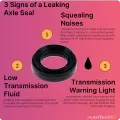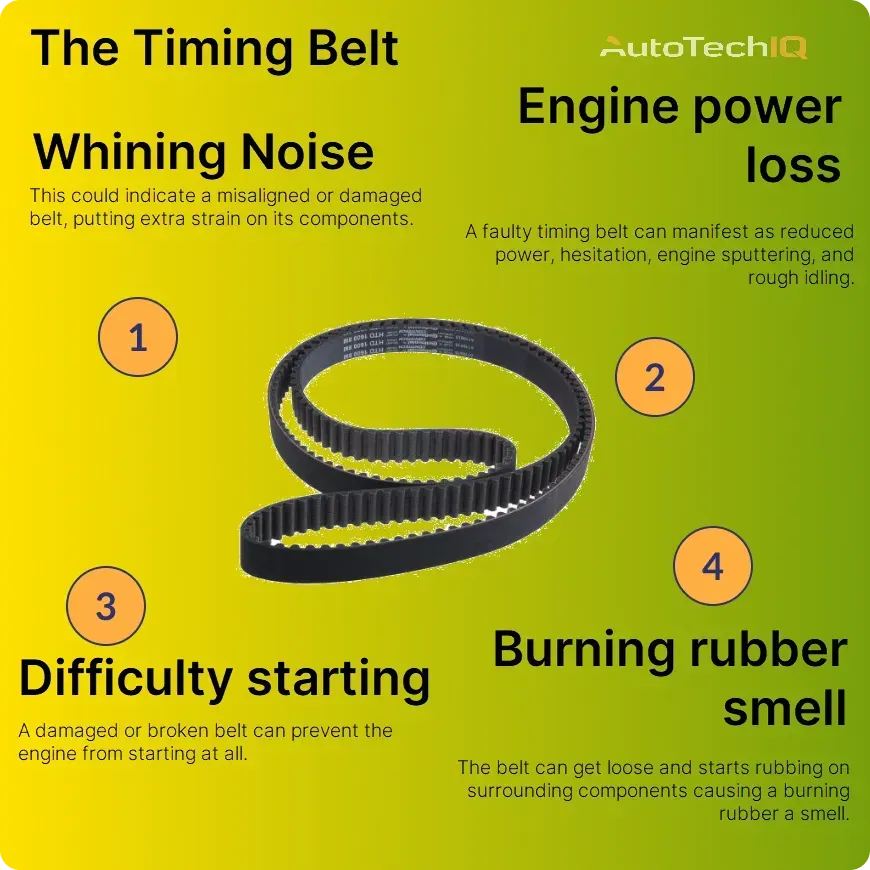
A timing belt, also known as a cambelt or timing chain, is a vital component in many internal combustion engines. It is a toothed rubber belt that synchronizes the rotation of the crankshaft and the camshaft, which are engine components. This synchronization is essential for ensuring that the engine's valves open and close at the correct times in relation to the position of the pistons.
Here's a breakdown of how it works:
- The crankshaft is responsible for converting the reciprocating motion of the pistons into rotary motion.
- The camshaft controls the opening and closing of the engine's valves.
- The timing belt connects the crankshaft and the camshaft, ensuring that they rotate at the same speed and in the correct sequence.
If the timing chain, which is either a timing belt fails, it can disrupt the synchronization between the crankshaft and the camshaft, which can lead to serious engine damage. It can also cause various odd sounds, similar to a loose drive belt. It is therefore important to replace the timing belt at regular intervals, as specified by your car's manufacturer.
Here are some additional things to keep in mind about timing chains (belts):
- They are typically made of a reinforced rubber compound that is resistant to wear and tear.
- They are located inside the engine, typically behind the timing cover. They look like a toothed belt and work alongside timing gears.
- They are usually replaced every 60,000 to 100,000 miles, but this can vary depending on the make and model of your car.
- Replacing a timing belt is a job that should be done by a qualified mechanic.
What are the signs of a bad timing belt?
Faulty timing belts can cause several issues in your car, some more noticeable than others. Here are some key signs to watch out for:
Engine noises:
- Ticking sound: This is a common symptom of a worn or loose timing belt. The ticking noise comes from the increased friction between the belt and the pulleys. This symptom can also carry others, like a check engine light and difficulty to accelerate.

- Whining noise: This could indicate a misaligned or damaged belt, putting extra strain on its components.
Engine performance:
- Engine power loss: A worn or stretched belt can disrupt the precise timing of valve opening and closing, leading to uneven engine operation. This can manifest as reduced power, hesitation, engine sputtering, and rough idling.
- Engine misfires: A worn or stretched belt can disrupt the precise timing of valve opening and closing, affecting the cylinder head and leading to misfires and internal combustion engine issues. This can manifest as reduced power, hesitation, engine sputtering, and rough idling.
- Difficulty starting: In severe cases, a damaged or broken belt can prevent the engine from starting at all. This often means that the belt isn't able to carry on the ignition switch's command.
- Increased exhaust emissions: Improper timing can cause incomplete fuel combustion. Commonly, an imbalance in the intake and exhaust valves.
Other signs:
- Burning rubber smell: The timing belt commonly has a rubber cover. If the belt or the cover gets loose and starts rubbing on any surrounding component or the belt itself, it'll cause a smell. The smell is typically similar to that of burning rubber.
- Oil leaks near the timing belt cover: A worn gasket or loose cover caused by belt issues can lead to oil leaks.
- Changes in RPMs: Fluctuations in engine RPMs, either higher or lower than usual, can indicate timing problems.
- Check engine light: While not specific to the timing belt, the check engine light can sometimes illuminate due to issues caused by a failing belt. This issue can also carry a noise along, similar to a lawn mower noise.

Additional tips:
- Mileage and time: Pay attention to your car's manufacturer's recommended timing belt replacement intervals, typically around 60,000 to 100,000 miles or 5-10 years, whichever comes first.
- Visual inspection: If you're comfortable, have a mechanic visually inspect the timing belt for cracks, fraying, or excessive wear.
Is it safe to drive with a faulty timing belt?
No, it is absolutely not safe to drive with a faulty timing belt. In fact, it is strongly discouraged under any circumstances. Here's why:
High risk of engine damage
A timing belt is crucial for coordinating the movement of your engine's pistons and valves. If it breaks while you're driving, these components can collide, causing significant and expensive damage to your engine. This could involve bent valves, broken pistons, or even a damaged cylinder head.
Sudden breakdown
When a faulty timing belt fails, it does so instantly, leaving you stranded wherever you are.
Unlike other car problems that might give you warning signs, a faulty timing belt often doesn't show any symptoms until it's too late.
Safety risk
If your car suddenly stalls due to a broken timing belt while you're driving, especially at high speeds, it can create a dangerous situation for yourself and others on the road.
What causes a timing belt to fail?
There are several factors that can contribute to a timing belt failing, and it's often a combination of them:
Age and wear: Like any rubber component, timing belts deteriorate over time and with use. The materials weaken, become brittle, and lose flexibility, making them more prone to cracking and snapping. This is why manufacturers recommend replacing them at specific mileage intervals, typically between 60,000 and 100,000 miles.
External damage: Contamination from oil, coolant, or debris can degrade the belt's material and accelerate wear. Additionally, contact with foreign objects like rocks or sticks can cause cuts or tears.
Misalignment or worn pulleys: If the pulleys that the belt runs on are misaligned or worn, it creates uneven stress on the belt, leading to premature wear and tear.
Excessive tension or slack: An overtightened belt puts unnecessary strain on itself and the tensioner, while a loose belt can slip and cause erratic engine timing. Both scenarios can contribute to faster wear and failure.
Defective parts: In rare cases, the belt itself might be faulty due to a manufacturing defect, although this is less common.
Extreme temperatures: Very hot or cold environments can accelerate the deterioration of the belt's materials, making it more brittle and susceptible to breakage.
Lack of maintenance: Failing to follow the recommended service schedule for checking and replacing the belt can lead to premature failure.
Remember, even if you don't experience any immediate symptoms, a faulty timing belt poses a significant risk of major engine damage if it breaks while driving.
How long do timing belts last?
The lifespan of a timing belt depends on several factors, making it difficult to give a single definitive answer. However, here's a breakdown of what influences their longevity and some general guidelines:
Factors Affecting Lifespan:
- Manufacturer and materials: Different manufacturers use varying materials and construction techniques, impacting durability. Some high-performance belts might last longer than standard ones.
- Driving conditions: Frequent stop-and-go traffic, extreme temperatures, and towing heavy loads put more stress on the belt, shortening its lifespan.
- Vehicle type and engine: Certain engines inherently put more strain on the belt, affecting its longevity. Consult your owner's manual for specific recommendations.
- Maintenance: Regular inspections and adhering to the manufacturer's replacement schedule are crucial for maximizing belt life.
General Guidelines:
- Mileage: Most modern timing belts are designed to last between 60,000 and 100,000 miles under normal driving conditions.
- Time: Regardless of mileage, manufacturers often recommend replacing the belt within a specific timeframe, usually around 7 years, even if the mileage hasn't reached the limit. This is because rubber degrades over time, even if unused.
Important points to remember:
- Do not exceed the recommended lifespan: Sticking to the manufacturer's replacement schedule or consulting a qualified mechanic for their assessment is crucial.
- Listen to your car: Be aware of unusual noises or performance changes that could indicate a problem with the belt.
- Don't gamble with safety: A broken timing belt can cause significant engine damage and safety risks. Prioritize preventative maintenance and replacement.
Recommendations
Get your timing belt inspected regularly: Consult your car's manual for the recommended replacement schedule and stick to it. Most manufacturers recommend replacing the timing belt between 60,000 and 100,000 miles.
Be aware of warning signs: While not always present, listen for unusual noises like ticking, squealing, or grinding coming from your engine. Any changes in power delivery or engine performance could also indicate a problem.
If you suspect a faulty timing belt, don't drive the car: Have it towed to a qualified mechanic for immediate inspection and repair.
Remember, ignoring these signs can lead to catastrophic engine damage. If you're noticing any issues that remind you of the signs discussed here, get a professional inspection. Call a Shop nearby (you can find one here).
Other news
-
Car is Squealing When Driving
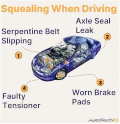
-
What is Preventative Maintenance and What Are The Benefits of it?

-
JobViewIQ - DVI Process Training - Part of the Auto Care Alliance Benefits

-
7 Signs of AC Pulley Issues
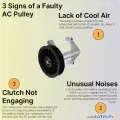
-
7 Signs of Clogged AC Components
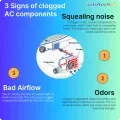
-
How Much Does a Transmission Fluid Change Cost?

-
7 Signs of a Leaking Axle Seal
